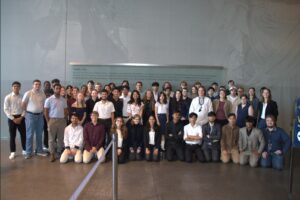Face Masks For a Year

Around this time last year we were eagerly packing to enjoy some time off during spring break. As we now know that week turned into two, which inevitably turned into the rest of the semester being conducted remotely. As we round the corner on one year of social-distancing it’s a wonder how we would have ever made it through 2020 without our wealth of technologies. Most of these technologies are obvious, our phones and computers for example. As well, we would have struggled immensely without programs like Zoom to help us transition to a remote learning environment. Though no technology has had more controversy the last year than the humble facemask.
For better or worse we spent the first few months of the pandemic trying to figure out if we should wear them or not. Now, months after it is clear that wearing one is ideal to help end the pandemic, new questions are emerging — questions like, ‘How effective are they?’ and ‘Which ones work best?’ Recently the Center for Disease Control released additional guidelines that included instructions for wearing multiple masks. This, of course, may make you wonder how many masks should be worn. Luckily, the CDC emphasizes that what is important is to limit the transmission of particles spreading from our mouths and noses into the communal air supply within buildings. The important thing to remember is to have a thick barrier of breathable fabric snug against the face. The CDC also stresses the importance of washing them frequently.
Over the last year it has been clear that technology played a fundamental role in surviving the pandemic. The use of any technology can often be marred by controversy. This is why it is so important to understand how things like facemask are intended to be used. When technology is used according to guidelines things like damage, injury, and even death can be minimalized and ideally avoided. The improper implementation of masks is a major concern because it can have the opposite effect of ending the pandemic.
Of course the biggest concerns surrounding the use of masks on this campus is wearing them during class. If you have been lucky enough to maintain any of your classes inside the classroom you will no doubt have noticed how much masks have impacted the experience of learning. Given the nature of how masks are worn they block the nose and mouth and make it difficult to communicate. Both teachers and students frequently comment on the difficulty of simply having a conversation during class. This has been slightly alleviated through the use of face shields when professors are giving lectures, though it should be known that the CDC recommends against using them as it is still unclear what part they play in spreading particulates. While this option is available for teaching faculty ultimately students must endure muffled conversation.
It is certainly a good feeling to be back on campus after the rushed transition to remote learning last spring. However, as we move into a second year of dealing with COVID-19, it is helpful to keep in mind the benefits and costs of using facemasks. Wearing a facemask is a critical part of ending the pandemic, but at the same time they also present new barriers that impact our ability to learn. The ability to communicate is hampered and using a facemask limits the amount of classroom discussion. As my lab for Dr. Gaylor’s Core of Discovery class was finishing up this week we discussed with him some nuances to wearing a facemask. Previously he has pointed out to the class that indeed the masks can trap some carbon dioxide gases as we breath out. After lab he went further to comment that prolonged talking in a mask can make some people lightheaded or dizzy. Another problem with wearing a mask is how they block the majority of the face, especially the mouth. Without being able to see another person’s facial reactions it becomes increasingly difficult to know how they have received what you told them. While this problem doesn’t impact us all the same it inevitably makes much of our conversations stilted.
While there are certainly drawbacks and frustrations that come as a result of wearing masks, the science seems to show that they have been effective in limiting the spread of the virus. Ultimately, the best we can do is ensure that everyone wears them, they fit properly, and they are washed frequently. Until the pandemic is over, we must remain mindful of why we continue to wear them.







